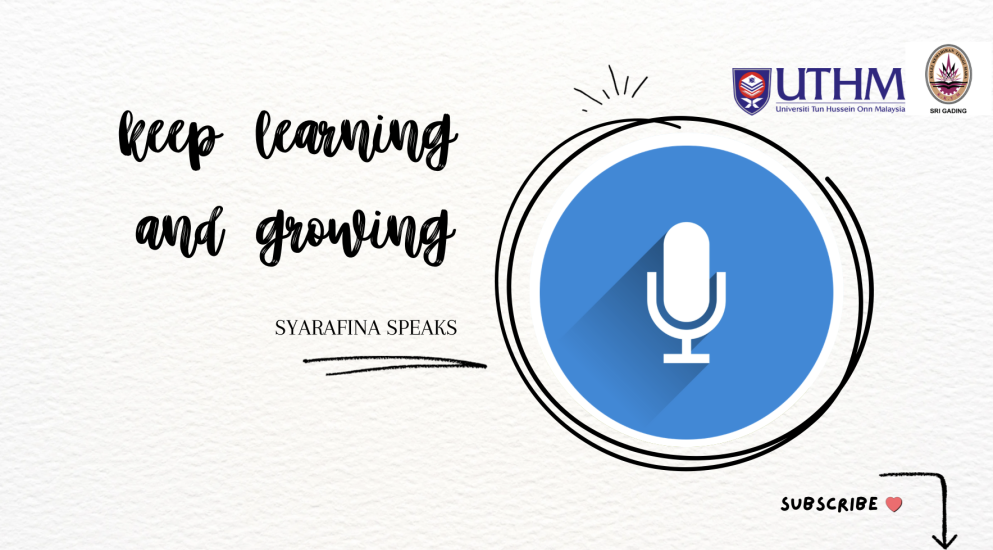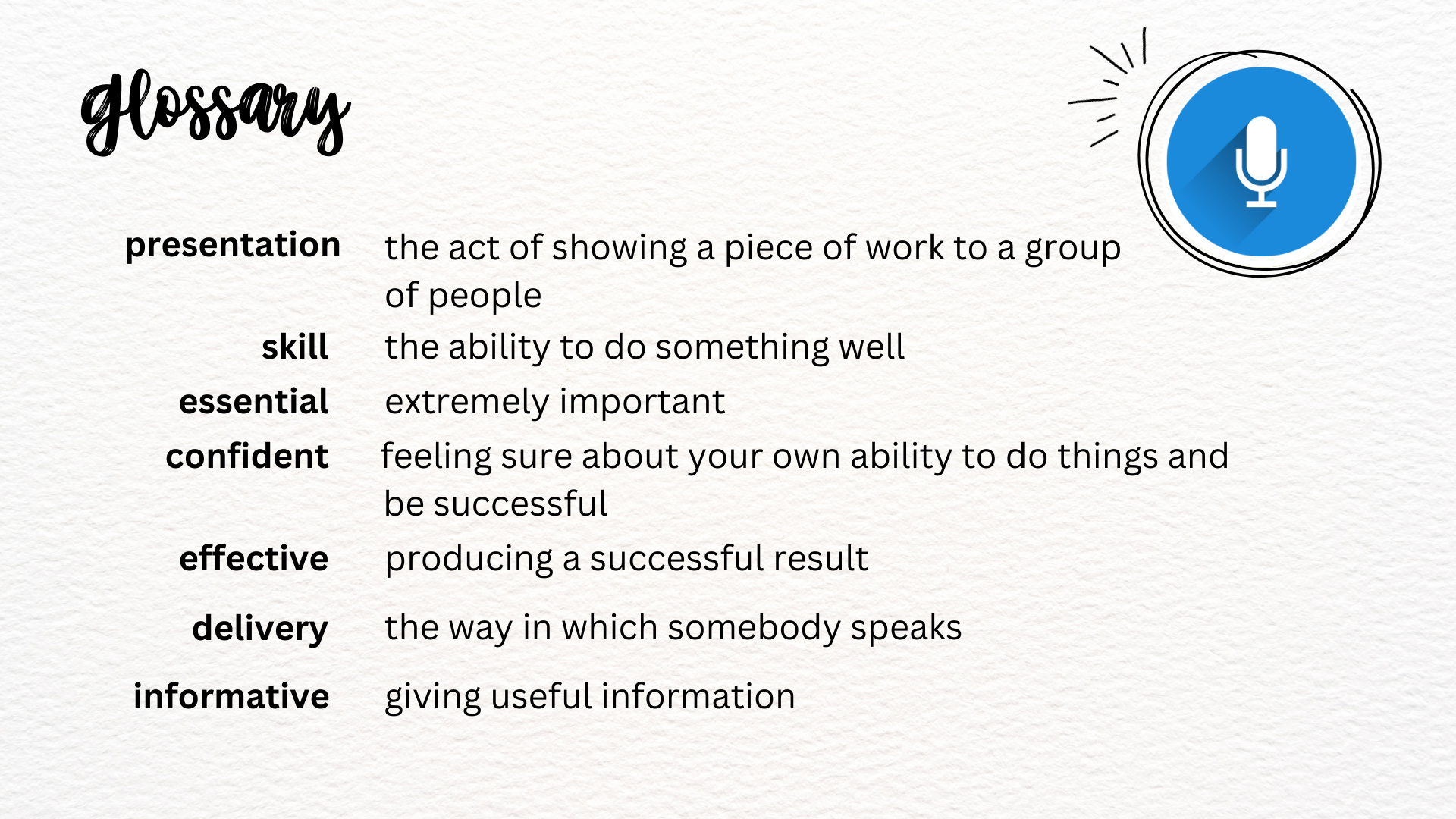Presentation Skills

Hello lovely students! I'm Fina, and I'm excited to have you here with me today. In this lesson, we'll be diving into the essential skills you need to master effective presentations. Whether you're presenting in a classroom, a boardroom, or virtually, these skills will help you engage your audience and deliver your message with confidence.
We'll cover topics such as structuring your presentation, using visual aids effectively, and mastering your delivery techniques. By the end of this session, you'll have practical tips and strategies to make your presentations not just informative, but also memorable and impactful.
So, let's get started and take your presentation skills to the next level! Thank you for joining me, and I hope you enjoy the lesson.
Learning Concept & Affective Domain
Learning Concept : Blended Learning | Competency Based Learning | Thinking Based Learning
Affective Domain : Oral Communication | Ethics & Professionalism | Self-confidence | Life-long Learning | Entrepreneurship Skill
Learning Outcomes
By the end of this session, you will identify :
1. Various types of presentations including informative, persuasive, training, image building, motivational and interview presentations.
2. Different types of visual aids, such as charts, graphs, infographics, videos and slide
3. Key elements of body language such as postures, gestures, facial expressions and eye contact.
Study Section 1 : Types of Presentations
We're going to explore the various types of presentations you might encounter or need to deliver. Understanding these different types will help you tailor your approach and connect more effectively with your audience!
1. Informative Presentations
First up, we have Informative Presentations.These are designed to provide your audience with information. They can be organized topically, chronologically, or spatially. Informative presentations fall into two categories: reporting and explaining. Reporting brings the audience up-to-date on projects through seminars, workshops, and conferences. Meanwhile, explaining types of informative presentation breaking down complex informationinto more digestible parts.
2. Persuasive Presentations
Persuasive presentations are those designed to influence an audience to accept certain positions or take specific actions. These presentations typically blend facts,logic and empathy to help the audience see an issue from a new perspective. Persuasive presentations are intended to get listeners to agree with you and act on that belief. Persuasive presenters employed strategies to shape, behaviours, feelings of an issue or object.
3. Training Presentations
Training Presentations focus on teaching specific skills.These can include sales techniques, diversity in the workplace, time management, and more. Clear learning objectives and thorough preparation are key. According to research study, training presentations are structured methods of delivering educational content to an audience with the goal of enhancing their knowledge, skills and competencies.
4. Image Building Presentations
Image Building Presentations are a blend of informative, entertaining, and goodwill-oriented content. They aim to position a company, or individual as a leader in their field. These presentations are innovative and dynamic,often serving as launching pads for extensive public relations and publicity efforts. The presentations are designed to enhance the perception and reputation of a person, organization, brand or product.
5. Motivational Presentations
Motivational Presentations are designed to inspire and energize the audience. These presenters know what makes their audience tick and use high-energy tactics to maintain attention. Whether it's a political candidate, a spiritual leader, or a motivational speaker, these presentations can leave a lasting impact on participants. These presentations should have a clear and compelling purpose, such as inspiring the audience to achieve their goals, overcome challenges or embrace change.
In conclusion, the key to a successful presentation lies in choosing the right type for your specific goal. Consider your audience, the content, and what you want them to take away. Finally, be flexible. Sometimes, combining elements from different types of presentations can be the most effective approach. Tailor your presentation to fit the needs of your audience
Study Section 2 : Types of Visual Aids
Visual aids are crucial for presentations as they enhance understanding, memory, and engagement. Images, diagrams, and charts help learners grasp complex ideas visually. They are especially useful for teaching abstract or difficult concepts. The presenter should ensure a logical flow in their presentation and use professional, relevant supporting materials. So, here are 5 types of visual aids that you can use to make your presentations more engaging:
1. Pictures, drawings, photographs
These can be very effective in presentations. As the saying goes, "a picture is worth a thousand words". However, this is true only when the images are relevant. Use them to illustrate your points. These vidual aids in presentation offer several strength that enhance communication and learning such as breaking down complex or abstract concepts into more simpler parts, making it easier for the audience to understand and retain information
2. Charts, graphs, diagrams, maps
These visual aids are commonly used to present data or facts. They help the audience see trends or patterns and complement descriptions of situations. For example, a chart showing grocery expenses over the past 30 days can reveal spending patterns and trends. They help convey complex information quickly and clearly. Digrams can break down complex processes or structures into more understandable fragmentation.
3. Handouts
Handouts are useful for meetings or training sessions, providing either all the information delivered or a summary of the presentation. They usually contain a summary and are helpful for covering a lot of information quickly. They allow audience to review the material at their own pace and retain the information better. Handouts can include more detailed information such as additional data and references. Handouts can serve as a guide for note-taking, helping the audience follow along with the presentation.
4. Objects
Objects are popular visual aids because they are real items representing the points you are making. They can effectively illustrate real things, ideas, data, or abstract concepts. Objects can maintain the audience's attention more effectively than words alone. They add a dynamic element to the presentations. Objects can make theoritical ideas more concrete and understandable. Audience are more likely to remember information when it is associated with a physical object.
5. Demonstrations
Demonstrations are visual aids that emphasize your point through hands-on learning. They are especially effective when showcasing a product as a prop and visual aid. Demonstrations often involve interaction, either by inviting audience participation by showing real-time results. This interactive element can enhance learning and make the presentation more dynamic. Seeing something work in real-time can be more convincing than hearing about it.
Remember, visual aids are powerful tools when used correctly. They can transform a good presentation into a great one. So, take the time to choose the right visuals aids and use them effectively.
Study Section 3 : Body Language & Gestures
We're going to talk about the power of body language and gestures in making your presentations more engaging and effective. The way you use your body can either enhance your message or distract from it. Let's explore some key tips to help you master your body language skills.
1. Correct Posture
First, let's talk about posture. Having a correct posture makes you look confident and in control. Stand up straight with your shoulders back. This not only makes you appear more self-assured but also helps you communicate your message clearly.
Do Maintain Good Posture : Stand up straight with your shoulders back. A confident posture makes you look more authoritative and helps you project your voice clearly.
Don't Slouch or Fidget : Avoid slouching or fidgeting, as it can make you appear nervous or unprepared. Stand or sit still and use controlled movements.
2. Eye Contact
Next, maintain eye contact.Eye contact helps you build a connection with your audience, making them feel appreciated and respected. It projects confidence and keeps your audience engaged. While it might be challenging to look at everyone, try scanning the room to make everyone feel included.
Do Make Eye Contact : Engage your audience by making eye contact. This builds connection and shows that you are confident and sincere.
Don't Avoid Eye Contact : Failing to make eye contact can make you seem disengaged or unsure.
3. Hand Gestures
Now, let's talk about hand gestures.Using hand gestures can make your message more engaging and memorable. Coordinate your gestures with your speech to emphasize key points, like using your fingers to denote something small. Remember, your gestures should be natural and flow with your speech
Do Use Hand Gestures : Use your hands to emphasize key points. Keep your hands visible and above your waist to make your gestures more effective.
Don't Overuse Hand Gestures : While hand gestures are helpful, overusing them can be distracting. Keep them natural and relevant to what you are saying.
4. Facial Expressions
Finally, facial expressions are crucial for connecting with your audience. Your face displays your emotions and helps convey your message. For instance, a smile can show warmth, while a furrowed brow can indicate seriousness. Use your eyebrows to express surprise or concern, nod your head to show agreement, and smile to share a happy story.
Do Smile and Use Facial Expressions : Show emotions through your facial expressions. A smile can convey warmth and friendliness, while a furrowed brow can show concern or seriousness.
Don't Have a Blank Expression : A blank face can make you appear disinterested or disconnected.
To sum up, by paying attention to your posture, maintaining eye contact, using effective hand gestures, and expressing emotions through your facial expressions, you can become a more effective communicator.
Thank you for joining me today.Practice these tips, and you'll see a significant improvement in your presentation skills.
See you next time!
Knowledge Check!
Here are some knowledge check questions to help you review the key concepts and assess your understanding!

This project is a collaborative effort between Centre for Virtual Learning (CVL), UTHM and Kolej Kemahiran Tinggi MARA Sri Gading (KKTM SG), aimed at enhancing flexible educational opportunities and supporting lifelong learning globally.
Contributors : Prof. Madya Ts. Dr. D'oria Islamiah Rosli, Ts. Dr. Sabariah Musa, Mr. Azman Ali, Ts. Wan Jazlan Zuhairi Ghazali, Prof.Ts. Dr. Abdul Rasid Abdul Razzaq, Ts. Dr. Mohd Hasril Amiruddin, Dr. Azita Ali, Dr. Nurhanim Saadah Abdullah, Mr. Hemmy Abd Jalal, Mr. Mohd Hidzam Othman, Ms. Noorhidayah Jaafar, Ms. Syaza Nazurah Khamsa, Ms. Afrina Farzana Azaruddin, Mr. Muhamad Nooradli Mohd Yazed, Mr. Muhammad Zulkifli Che Lah, Mr. Mohd Adlan Badarudin, Ms. Siti Hasnah Hud, Ms. Halijah Sa'don, Mr. Mohd Esaruddin Ebas
Thank you for your exceptional guidance, technical support and expertise and insightful feedback throughout this internship.




